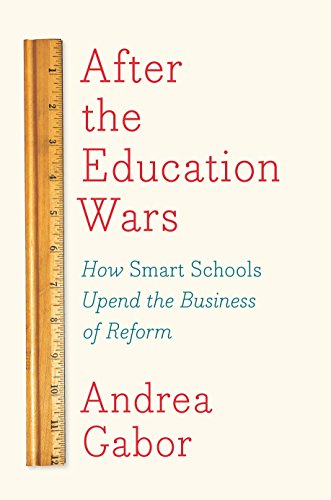Schools Done the W. Edwards Deming Way?
After the Education Wars: How Smart Schools Upend the Business of Reform, by Andrea Gabor
Andrea Gabor is the Bloomberg chair of business journalism at the Baruch School, CUNY. Having published in The Harvard Business Review, Fortune, Business Week, and The New York Times, she is well grounded in the history of business thought as well as its current practices. Gabor is a long-time fan of W. Edwards Deming and continuous improvement. In this book she excoriates conventional business thinking as the bane of quality K-12 education. By inference business thought is the bane of Deming’s philosophy too.
Gabor’s business school background shows. Written in B-school case study style, most of the book is detailed case histories of four school districts: New York City, New Orleans, Brockton, Massachusetts, and Leander, Texas. Well researched, each case details the travails of teacher-led, locally governed K-12 schools bucking the trends of charter schools, top down control, and teach-to-test. Anyone who has taught at any level can relate to Gabor’s cases: if you can interest kids or adults in learning, they genuinely learn. If they regard school as a regimen of incarceration, they also learn – how to beat the system.
Business philanthropists and politicians mean well, but their education reforms are misguided. They think that frequent measurement of results is necessary to guide improvement, and test scores are the primary criterion for success. Therefore tie teacher evaluations, teacher job retention, administrator performance, and school funding to the scores. The result is a culture of fear pervading the system. Students, teachers, administrators, and governing boards, all live in fear of failure. In addition, the hierarchy of adminstration a big bloated bureaucracy of people “there to help.”
Gabor decries this reversion to top-down Taylorist one-best-way practices in education when in the business world Taylorism is slowly giving way to continuous improvement with employee engagement. (Taylor was the “Father of Scientific Management at the beginning of the 20thcentury.) Curiously, not only do business tyrants embrace Taylorism, so-called liberal businessmen and politicians do too, and Gabor fingers Bill Gates and Bill DeBlasio as culprits. The George W. Bush administration had its top down No-Child-Left-Behind program. The Obama administration shifted to Race-to-the-Top, but still top down. Business philanthropists push these top-down Taylorist concepts in public schools, charter schools, and private schools. Few of these are outstanding by their own criteria, test scores and college placements.
So what is working? What makes an outstanding school? First, their criteria of success were broad. Outstanding schools regarded their mission as educating kids to function in democracies and communities first; developing skills to get a job second. Curricula included civics, art, music, field trips, and participative exercises.
In her final chapter, Gabor summarizes her recommendations based on the case studies. These recommendations make the biggest differences in poor districts with many disadvantaged students:
- Teacher voice and teacher innovation with local decision-making that includes both administrators and the community, especially parents. Existence of a teacher’s union occasionally poses an obstacle, but in the end makes no difference if teachers love to teach. In the best schools teacher turnover was low. Most teachers had been there many years. New teachers worked their way in, being coached in what worked or didn’t at that school. They had various kinds of improvement meetings and dialogs. Newbies objecting to this usually dropped out.
- Equitable funding. With less administrative overhead, decentralized schooling costs no more, but no system works if it is starved for funds. Differences in the funding of rich vs. poor districts are often huge.
- Strong leadership is crucial. Not only must leaders be enthusiastic, they must protect local innovation from well-meaning outsiders who think that they have a better idea. The best leaders came from the community and deeply understood it. Educating pupils is unlike replicating widgets – or programming little robots. Turning around a failing education program takes several years. And in Deming’s verbiage, it takes constancy of purpose.
- Development of a clear strategy for improvement and promulgating it to be widely embraced. In Brockton’s case, this strategy was comprehensive literacy. Teachers innovate together when they are not going in all different directions.
- Accountability within a coherent framework and at intervals that leave time to innovate. Locals know when an approach is working or not without disrupting the process for tests that may or may not support the teaching strategy.
Gabor’s themes complement those of a book reviewed in the last issue, Winners Take All by Anand Giriharadas. Both puncture the hubris of business leaders insisting that running anything like a business will surely better its performance. Taylorism does not work in education – or health care either. There, human engagement and relationships are crucial. Success does not reduce to cost control and quantified performance measurement, nor is it magically achieved in a short time.
None of the schools touted were perfect. Perfection will never be found, but all the Deming philosophy schools battled would-be reformers convinced that no matter how well a school is thriving, “business principles” would surely improve it. The lessons from Gabor’s best schools might even improve leadership of a lot of businesses.

